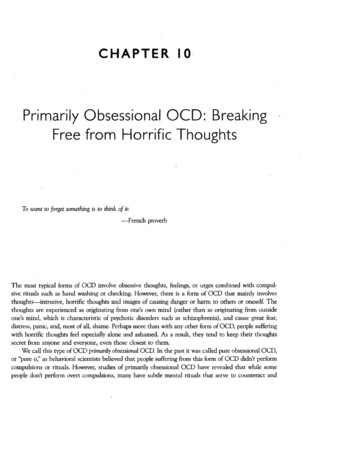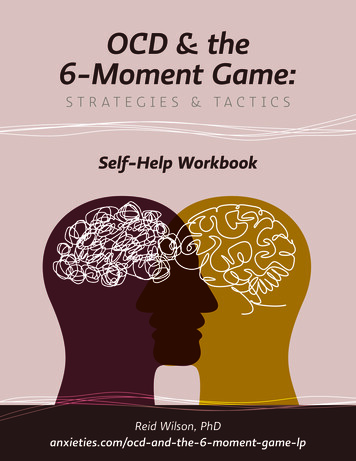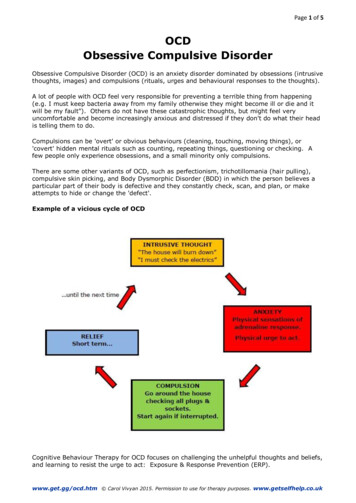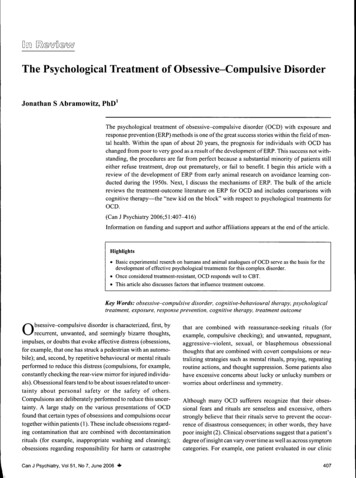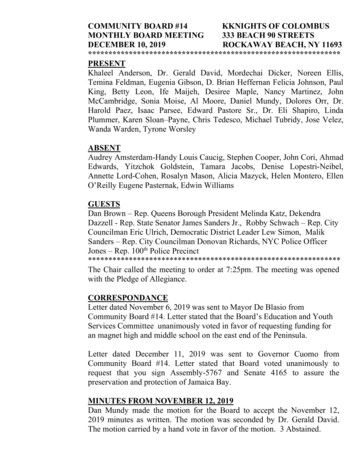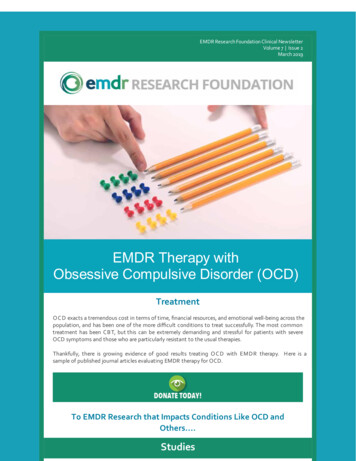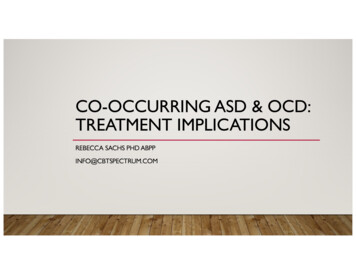
Transcription
CO-OCCURRING ASD & OCD:TREATMENT IMPLICATIONSREBECCA SACHS PHD ABPPINFO@CBTSPECTRUM.COM
Autistic On the SpectrumAUTISMSPECTRUMDISORDERS Person with Autism Asperger’s uk/about/what-is/asperger.aspx
AUTISM SPECTRUM DISORDERSDevelopmentalDisorder- LifelongSpectrum & severitylevel rating: how muchsupport is neededDeficits in socialcommunication & socialinteractionRestricted, repetitivepatters of behavior,interestsSocial-emotional reciprocityNonverbal communicationDeveloping, maintaining &understandingrelationships/social contextsRepetitive motor movements,use of speechInsistence on sameness,routines & ritualsHighly restrictive, fixatedinterests, abnormal inintensity/focusSensory sensitivities
Children with ASD Become Adults with ASDWHY WE ARETALKINGABOUT THISChildren & Adults with ASD Have Similar MentalHealth Problems as Typical AdultsChildren & Adults with ASD experiencePsychopathology at Higher RatesPeople with ASD Can Benefit fromPsychotherapySymptoms of Autism Can Present in People WhoHave Strong Cognitive & Verbal Abilities
Teach new cognitive & behavioral skills thatwere never learned (including those todecrease/prevent OCD, such as ERP and otherco-occurring mental health problems)PHILOSOPHY OFCHANGETeach compensatory strategies fordeficits/differences that cannot be changed(including self-advocacy)Facilitate self-acceptance
SEVERITY LEVELSOCIAL COMMUNICATIONRRBLevel 3: Requiring verysubstantial supportSevere deficits in verbal andnonverbal social communicationthat causes severe impairment infunctioning.Inflexibility of behavior, extreme difficulty copingwith change, or other rrb that markedly interferewith functioning in all spheres. Greatdistress/difficulty changing focus/action.Level 2: Requiring substantialsupportMarked deficits in verbal andnonverbal social communication;impairments apparent even withsupports in place.Inflexibility of behavior, difficulty coping withchange, or other RRB that appear frequentlyenough to be obvious and interfere withfunctioning in a variety of contexts.Distress/difficulty changing focus/action.Level 1: Requiring supportWithout supports in place, deficitsin social communication causenoticeable impairments.Inflexibility of behavior causes significantinterference with functioning in one or morecontexts. Difficulty switching between activities.Problems of organization and planning hamperindependence.
From:Cognitive BehavioralTherapy for Adults withAutism SpectrumDisorder: 2nd Ed.,Guilford Pressby Valerie L. Gaus
SMART GOALS & PAYOFF MATRIXSpecific (clear, concrete, well defined)Measurable (observed and tracked over time)Attainable (can actually be achieved)Relevant (important & meaningful to you)Time-bound (specific amount of time when something isgoing to happen)
WHY DO A FUNCTIONALASSESSMENT?
FUNCTION &REINFORCEMENT All behaviors are functional Behaviors happen and are maintainedfor a reason Not manipulative. Rather, they “work”or serve a purpose Sensory EscapeAttentionTangible(Medical)
MOTIVATIONNegative Reinforcement Getting out of something bad/escapeMay be atypicalPositive ReinforcementMay be atypical “Don’t you want to .” Getting something wanted Social motivation may be different.
ASSESSMENT OF SKILLS &CHALLENGES
urechallenges/
ADAPTIVE SKILLSCHALLENGES Need for increased independence interms of self-care, daily living skillsand community skills Money management Medical care Access to services and support Travel Readiness Perspective taking & understandingthe value of effective strategies interms of impact upon professionaland social functioning
KEEP ACCOUNTABLE & SLOW THE PACEAntecedentsCommunicating Expectations Visual agenda- keeping tasks &expectations concrete & visual Draw on your CBTexperiences (like schedulingbehavior activation & behavioralcontracts)ConsequencesIncorporating RF Labeled praise/Tangible/Privilege Get out of something* Reinforcement should servesimilar function of behavior(attention, tangible, escape,sensory)
CONSISTENT METAPHORS & INCORPORATINGPREFERRED INTERESTUse consistent metaphorsweek to weekIncorporating preferredinterests (therapist mayneed need to do their“HW” on this) but keep itbalancedRemember your goal is toapproach vs. avoidYou can capitalize on thespecial interest *it can be sopowerful!
ESCAPE:“I CAN’T HANDLE IT”
DEALING WITH EMOTIONS This Photo by Unknown Author is licensed under CC BYThis Photo by Unknown Author is licensed under CC BY
From:Unified Protocol forTransdiagnosticTreatment of EmotionalDisorders inAdolescents Oxfordby Ehrenreich-May etal.
ACCESSING THE RIGHT SUPPORTS(ALL THE FUNCTIONS)
Premack’s Principle (Grandma’s Rule)Asking for helpSKILLS TOTEACH &MODELProblem SolvingSelf Advocacy & Assertive Communication Fact-Feeling- Fair Request When I see/hear , I feel , because . So Iwould likeReflective Listening What I’m hearing you say is . Did I understandyou?
FAMILYACCOMMODATIONVS ADVOCACY
RESOURCES https://www.spectrumnews.org https://www.aane.org https://www.socialthinking.comBooks Spectrums Autism: What Does It Mean to Me?: A Workbook Explaining Self Awareness and Life Lessons to the Child or Youth with HighFunctioning Autism or Asperger A Workbook Explaining Self Awareness and Life Lessons to the Child or Youth with HighFunctioning Autism or Aspergers Living Well on the Spectrum: How to Use Your Strengths to Meet the Challenges of Asperger Syndrome/High-Functioning Autism How toUse Your Strengths to Meet the Challenges of Asperger Syndrome/High-Functioning Autism The Hidden Curriculum for Understanding Unstated Rules in Social Situations for Adolescents and Young Adults Uniquely Human: A Different Way of Seeing Autism Cognitive-Behavioral Therapy for Adults with Autism Spectrum Disorder, Second Edition Second Edition
decrease/prevent OCD, such as ERP and other co-occurring mental health problems) Teach compensatory strategies for deficits/differences that cannot be changed (including self-advocacy) . A Workbook Explaining Self Awareness and Life Lessons to the Child or Youth with High

